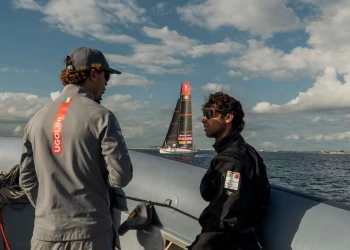
Luna Rossa: flying like an airplane, or almost
Luna Rossa: flying like an airplane, or almost
The new America's Cup boats, quite literally, fly. Although only 17 years have gone by since the 2007 America's Cup in Valencia, the last one raced onboard the ACC Class, yacht design has undergone a revolution, moving from slow displacement hulls (averaging 12 knots of speed) to the astounding speeds of the AC75 foiling monohulls (over 50 knots).
Matteo Ledri and Andres Suar - respectively fluid dynamics expert and naval architect at Luna Rossa Prada Pirelli - explain how the new flying boats work.
«Luna Rossa flies thanks to her foils, wings that are underwater, very similar to those of an airplane, only smaller», Ledri says. The way it works, however, is the same: «By reaching a certain speed, these wings are able to create an upward force that allows the boat to rise».
Once the hull is out of the water, the reduction of friction and drag greatly increases its speed potential.
«Unlike an airplane, we can't give the boat the power we want», Suar explains, «but we can contribute by working on the foils and sails».
Sailors apply control by means of an aircraft-like flap, whose angle must be constantly controlled to adapt to the boat’s endless changes in trim and speed. «Initially, you have to position yourself at an efficient angle of about 90° to the wind and work with sails and foils to keep the boat in a balance that corresponds to about 0° of heel», Suar continues; «at this point you have to try to accelerate slowly in the most efficient way, giving as much power as possible with the sails, but not trimming too much the foils».
Once you reach takeoff speed - between 18 and 23 knots - you can adjust the flaps and try to take off to further increase speed.
Since both the speed potential and the forces involved have grown tremendously over the years, the design of the components has also changed accordingly. «The important thing is to have parts small enough so they don't offer too much resistance», Ledri continues.
New boats require new skills and new specializations. At Luna Rossa Prada Pirelli, in fact, there are several departments working in synergy (performance, hydro and fluid dynamics, analysis, structures, hardware and others) to make sure that each moving component has easy and efficient control systems.
«The ultimate 'customers' are the sailors», Ledri concludes. «Our job is to listen and analyze their feedback to build simple, reliable systems that allow optimal performance and the best results».





